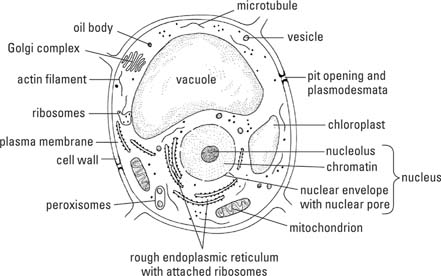Four features set apart plant cells from those of other organisms:
- A cellulose cell wall; many protists, some fungi, and most bacteria also have rigid walls, but made of different materials, e.g. Chitin strengthens fungal cell walls and peptidoglycan those of bacteria.
- Plasmodesmata, strands of cytoplasm that protrude through pores in the cell walls and connect the protoplasts of adjacent cells; these are avenues of material transport in plants.

Figure 1
- Plastids, organelles thought to have an endosymbiotic origin; they have an intricate internal structure of folded membranes that greatly increases the internal surface area on which chemical reactions occur; chloroplasts contain chlorophyll, and their thylakoid membranes are the sites of photosynthesis.
- Vacuoles are fluid filled sacs present in plants, animals, and some protists; those of plants differ from others in size and function, i.e. a typical plant cell has a single, centrally located vacuole whose water‐filled interior pushes the cytoplasm outward against the cell wall giving rigidity or turgidity to the cell.
Not all functional cells in plants are alive. Many cells live for only a short time then die, but their cell walls remain in place giving strength and rigidity to the plant body. The dead cells of xylem tissue form effective conduits for water between the roots and the above ground tissues.
Plant cells vary greatly in shape and function, but in general each has a cell wall surrounding a protoplast, which is differentiated into a nucleus and cytoplasm. Suspended within the watery cytoplasm are the membranes, organelles, and particles in which the biochemical processes of life occur. The nucleus contains most of the cellular DNA and is thus the center from which these cellular activities are directed. Cytoplasm is in more or less constant motion in living cells and the movement is termed cyclosis or cytoplasmic streaming. ( Protoplasm is a commonly used name for all the watery cellular matter. It incudes the nucleoplasm of the nucleus plus the cytoplasm.)
The cell wall is produced by the cytoplasm and deposited outside of the plasma membrane—the outer boundary of the protoplast. The wall and plasma membrane regulate the kinds of materials that enter and leave the cell thus making it possible for the cell to maintain an identity different from its surroundings. The wall is not simply an inert substance providing strength and giving structure to plant cells as once was thought, but is active in several metabolic processes including absorption and secretion of substances, the detection of bacterial and fungal pathogens, and even regulation of growth and development.
Cellulose, the most common material of plant cell walls, is a polysaccharide composed of long chains of glucose molecules that assume crystalline properties in the cell wall. During wall formation, adjacent cellulose molecules link together forming bundles called microfibrils. The microfibrils, in turn, twist together rope‐like, producing strong cords called macrofibrils. Hemicelluloses and pectins are deposited among the fibril network and chemically bind the whole together. The result is a primary wall. The whole process of synthesis and assembly is coordinated by the plasma membrane.
Lignin, the second most common material of plant cell walls, adds additional strength to cells, such as in wood cells. Other substances are deposited in walls of tissues serving particular functions. Walls of cells in the outer layer of leaves often contain cutin or waxes, both of which effectively reduce the loss of water from the leaves. Walls of cork cells in the bark of trees contain suberin, another type of protective material.
Membranes:
- Are the sites of many of the biochemical processes of life.
- Are in constant flux, changing both their physical and chemical structure and composition as long as the cell is alive.
- Partition the cell into compartments in which metabolic reactions take place independently of processes occurring in nearby compartments, thus permitting a variety of reactions to occur simultaneously within a single cell.
The basic structure of all biological membranes is the same: a double layer of lipids in which proteins are embedded. The ratio of proteins to lipids is 3:2. Some of the proteins extend through the lipid layer, each end of a molecule projecting out opposite sides. Others remain on or partially embedded in one or the other surface.
Most membranes are selectively (differentially) permeable, permitting or preventing materials from leaving or entering the cell. When toxic substances destroy the selective permeability and the membrane becomes freely permeable, materials leak unchecked in and out, resulting in death of the cell.
Although it is difficult to study the plasma membrane separately from the rest of the protoplast, it is known that the plasma membrane deciphers the biochemical signals that control cell growth and differentiation and that it organizes the formation of the cell wall.
Table 1 shows cell structures, their composition, and principal functions.
|
|
|
|
|
|
|
|
|
|
|
|
|
|
|
|
|
|
|
|
|
|
|
|
|
|
|
|
|
|
|
|
|
|
